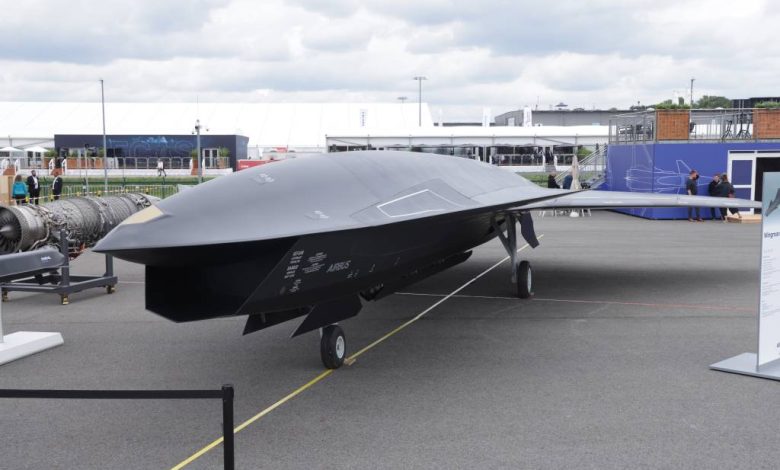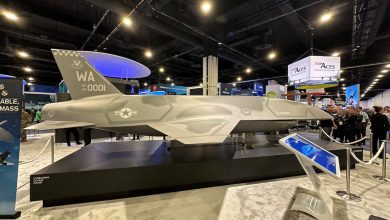Airbus, Diehl aim at future air war with drone wingman, remote carrier

PARIS — Airbus and Diehl Defence provided a glimpse at the future of air combat, presenting concepts for stealthy drone systems that will be able to team up with manned aircraft such as Eurofighter or Rafale years before a future European sixth-generation fighter becomes reality.
Airbus showed off its Wingman concept, a large fighter-type stealth drone to fly alongside piloted jets such as the Eurofighter, at the Berlin Air Show near the German capital on Wednesday. The company also signed an agreement with German defense-software startup Helsing to develop artificial-intelligence technology for a future Wingman system.
Diehl presented a model of a new light remote carrier called Feanix, a drone that can be air launched with payloads including sensors or lethal and non-lethal effectors, and stealth aspects that make it hard to detect by enemy air defenses. The company said it’s been self-financing research into light remote carriers, which it dubbed the missiles of the future.
Germany has called for faster fielding of military drones than the timeline envisaged for the Future Combat Air System (FCAS) being developed with France and Spain. The French senate has said the sixth-generation fighter at the core of FCAS won’t be available before 2045 or 2050, and has called for a wingman drone for the Rafale fighter.
“The current conflicts on Europe’s borders show how important air superiority is,” Airbus Defence and Space CEO Mike Schoellhorn said in a statement on Wednesday. “Manned-unmanned teaming will play a central role in achieving air superiority: with an unmanned Wingman at their side, fighter pilots can operate outside the danger zone.”
Most of the world’s military powers are developing future air-combat systems combining a sixth-generation fighter with unmanned systems. In the U.S., the Kratos XQ-58A Valkyrie drone in 2021 successfully launched a smaller unmanned aircraft from its internal weapons bay, while the U.K. is developing remote carriers as part of the Tempest project.
Many of the developments in unmanned vehicles are in response to a critical need to compensate for a shortfall in the number of conventional combat aircraft, French think-tank Fondation pour la Recherche Stratégique said in an April report.
Airbus is the prime contractor for the remote carriers that will be part of FCAS, with missile maker MBDA and Spain’s Satnus as the main partners. German air force chief Lt. Gen. Ingo Gerhartz said in November that remote carriers resulting from the program were needed “much, much earlier” than the 2040s.
The Wingman concept drone is Airbus’s answer to the German Air Force’s “clear need” for an unmanned companion aircraft before FCAS will be operational, and can result in an “affordable solution” for Germany for the 2030s, according to Schoellhorn. The drone can take over dangerous tasks such as target reconnaissance and destroying or jamming of enemy air defenses.
Artificial intelligence will be a critical component of the system for the German Air Force, Helsing co-CEO Gundbert Scherf said in a statement. “Whilst we will always have a human in the loop, we must realize that the most dangerous parts of an unmanned mission will see a high degree of autonomy and thus require AI,” he said.
Airbus is self-funding the Wingman effort to develop the technologies for entry into service in the early 2030s, in order to operate alongside current-generation aircraft such as the Eurofighter, an Airbus spokesman said in an emailed response to questions. The company is in talks with Germany and Spain about the concept, but no program has been started.
While the most obvious use case is the Eurofighter, the Airbus drone could work with other fighters such as Rafale, Gripen or the F-35, or even larger aircraft such as the A400M transporter or A330 MRTT tanker, the company said.
Dassault Aviation has been working on its nEUROn drone, which the French senate has said could be the basis for an unmanned wingman for the Rafale. The program’s technological demonstrator completed its first flight in December 2012, and first released a weapon from the internal bay in September 2015.
The Airbus Wingman drone on display in Berlin has a wingspan of 12 meters and an overall length of 15.5 meters, and the company expects the aircraft would operate at high transonic speed, so around the speed of sound.
The Diehl drone is significantly smaller, and a length of less than 4 meters and weight of less than 300 kilograms means the unmanned aircraft could be air launched. Pan-European missile maker MBDA has been working on similar remote carriers.
“Remote carriers are a core element of the international FCAS program, but are also used beyond the FCAS role, which is why Diehl Defence aims for an operational availability well before the FCAS realization period of 2040 plus,” the company said in a statement on Wednesday.
The teaming and swarming capability of the system will be a game changer in future scenarios, the company said. Light remote carriers operation will be highly automated and independent from the carrier system, with high numbers providing combat mass, Diehl said.
Rudy Ruitenberg is a Europe correspondent for Defense News. He started his career at Bloomberg News and has experience reporting on technology, commodity markets and politics.







